Jun Lan
Veritas: Generalizable Deepfake Detection via Pattern-Aware Reasoning
Aug 28, 2025Abstract:Deepfake detection remains a formidable challenge due to the complex and evolving nature of fake content in real-world scenarios. However, existing academic benchmarks suffer from severe discrepancies from industrial practice, typically featuring homogeneous training sources and low-quality testing images, which hinder the practical deployments of current detectors. To mitigate this gap, we introduce HydraFake, a dataset that simulates real-world challenges with hierarchical generalization testing. Specifically, HydraFake involves diversified deepfake techniques and in-the-wild forgeries, along with rigorous training and evaluation protocol, covering unseen model architectures, emerging forgery techniques and novel data domains. Building on this resource, we propose Veritas, a multi-modal large language model (MLLM) based deepfake detector. Different from vanilla chain-of-thought (CoT), we introduce pattern-aware reasoning that involves critical reasoning patterns such as "planning" and "self-reflection" to emulate human forensic process. We further propose a two-stage training pipeline to seamlessly internalize such deepfake reasoning capacities into current MLLMs. Experiments on HydraFake dataset reveal that although previous detectors show great generalization on cross-model scenarios, they fall short on unseen forgeries and data domains. Our Veritas achieves significant gains across different OOD scenarios, and is capable of delivering transparent and faithful detection outputs.
Interpretable and Reliable Detection of AI-Generated Images via Grounded Reasoning in MLLMs
Jun 08, 2025Abstract:The rapid advancement of image generation technologies intensifies the demand for interpretable and robust detection methods. Although existing approaches often attain high accuracy, they typically operate as black boxes without providing human-understandable justifications. Multi-modal Large Language Models (MLLMs), while not originally intended for forgery detection, exhibit strong analytical and reasoning capabilities. When properly fine-tuned, they can effectively identify AI-generated images and offer meaningful explanations. However, existing MLLMs still struggle with hallucination and often fail to align their visual interpretations with actual image content and human reasoning. To bridge this gap, we construct a dataset of AI-generated images annotated with bounding boxes and descriptive captions that highlight synthesis artifacts, establishing a foundation for human-aligned visual-textual grounded reasoning. We then finetune MLLMs through a multi-stage optimization strategy that progressively balances the objectives of accurate detection, visual localization, and coherent textual explanation. The resulting model achieves superior performance in both detecting AI-generated images and localizing visual flaws, significantly outperforming baseline methods.
NTIRE 2025 challenge on Text to Image Generation Model Quality Assessment
May 22, 2025Abstract:This paper reports on the NTIRE 2025 challenge on Text to Image (T2I) generation model quality assessment, which will be held in conjunction with the New Trends in Image Restoration and Enhancement Workshop (NTIRE) at CVPR 2025. The aim of this challenge is to address the fine-grained quality assessment of text-to-image generation models. This challenge evaluates text-to-image models from two aspects: image-text alignment and image structural distortion detection, and is divided into the alignment track and the structural track. The alignment track uses the EvalMuse-40K, which contains around 40K AI-Generated Images (AIGIs) generated by 20 popular generative models. The alignment track has a total of 371 registered participants. A total of 1,883 submissions are received in the development phase, and 507 submissions are received in the test phase. Finally, 12 participating teams submitted their models and fact sheets. The structure track uses the EvalMuse-Structure, which contains 10,000 AI-Generated Images (AIGIs) with corresponding structural distortion mask. A total of 211 participants have registered in the structure track. A total of 1155 submissions are received in the development phase, and 487 submissions are received in the test phase. Finally, 8 participating teams submitted their models and fact sheets. Almost all methods have achieved better results than baseline methods, and the winning methods in both tracks have demonstrated superior prediction performance on T2I model quality assessment.
Benchmarking Unified Face Attack Detection via Hierarchical Prompt Tuning
May 19, 2025Abstract:Presentation Attack Detection and Face Forgery Detection are designed to protect face data from physical media-based Presentation Attacks and digital editing-based DeepFakes respectively. But separate training of these two models makes them vulnerable to unknown attacks and burdens deployment environments. The lack of a Unified Face Attack Detection model to handle both types of attacks is mainly due to two factors. First, there's a lack of adequate benchmarks for models to explore. Existing UAD datasets have limited attack types and samples, restricting the model's ability to address advanced threats. To address this, we propose UniAttackDataPlus (UniAttackData+), the most extensive and sophisticated collection of forgery techniques to date. It includes 2,875 identities and their 54 kinds of falsified samples, totaling 697,347 videos. Second, there's a lack of a reliable classification criterion. Current methods try to find an arbitrary criterion within the same semantic space, which fails when encountering diverse attacks. So, we present a novel Visual-Language Model-based Hierarchical Prompt Tuning Framework (HiPTune) that adaptively explores multiple classification criteria from different semantic spaces. We build a Visual Prompt Tree to explore various classification rules hierarchically. Then, by adaptively pruning the prompts, the model can select the most suitable prompts to guide the encoder to extract discriminative features at different levels in a coarse-to-fine way. Finally, to help the model understand the classification criteria in visual space, we propose a Dynamically Prompt Integration module to project the visual prompts to the text encoder for more accurate semantics. Experiments on 12 datasets have shown the potential to inspire further innovations in the UAD field.
COCO-Inpaint: A Benchmark for Image Inpainting Detection and Manipulation Localization
Apr 25, 2025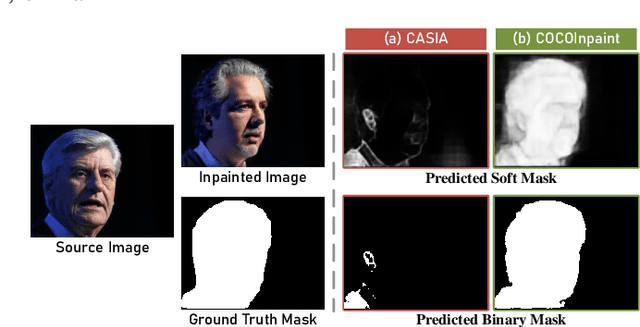

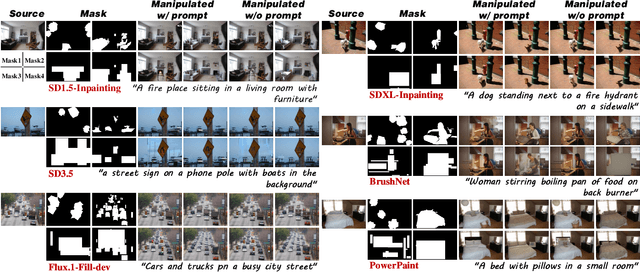

Abstract:Recent advancements in image manipulation have achieved unprecedented progress in generating photorealistic content, but also simultaneously eliminating barriers to arbitrary manipulation and editing, raising concerns about multimedia authenticity and cybersecurity. However, existing Image Manipulation Detection and Localization (IMDL) methodologies predominantly focus on splicing or copy-move forgeries, lacking dedicated benchmarks for inpainting-based manipulations. To bridge this gap, we present COCOInpaint, a comprehensive benchmark specifically designed for inpainting detection, with three key contributions: 1) High-quality inpainting samples generated by six state-of-the-art inpainting models, 2) Diverse generation scenarios enabled by four mask generation strategies with optional text guidance, and 3) Large-scale coverage with 258,266 inpainted images with rich semantic diversity. Our benchmark is constructed to emphasize intrinsic inconsistencies between inpainted and authentic regions, rather than superficial semantic artifacts such as object shapes. We establish a rigorous evaluation protocol using three standard metrics to assess existing IMDL approaches. The dataset will be made publicly available to facilitate future research in this area.
InterAnimate: Taming Region-aware Diffusion Model for Realistic Human Interaction Animation
Apr 15, 2025Abstract:Recent video generation research has focused heavily on isolated actions, leaving interactive motions-such as hand-face interactions-largely unexamined. These interactions are essential for emerging biometric authentication systems, which rely on interactive motion-based anti-spoofing approaches. From a security perspective, there is a growing need for large-scale, high-quality interactive videos to train and strengthen authentication models. In this work, we introduce a novel paradigm for animating realistic hand-face interactions. Our approach simultaneously learns spatio-temporal contact dynamics and biomechanically plausible deformation effects, enabling natural interactions where hand movements induce anatomically accurate facial deformations while maintaining collision-free contact. To facilitate this research, we present InterHF, a large-scale hand-face interaction dataset featuring 18 interaction patterns and 90,000 annotated videos. Additionally, we propose InterAnimate, a region-aware diffusion model designed specifically for interaction animation. InterAnimate leverages learnable spatial and temporal latents to effectively capture dynamic interaction priors and integrates a region-aware interaction mechanism that injects these priors into the denoising process. To the best of our knowledge, this work represents the first large-scale effort to systematically study human hand-face interactions. Qualitative and quantitative results show InterAnimate produces highly realistic animations, setting a new benchmark. Code and data will be made public to advance research.
Maintain Plasticity in Long-timescale Continual Test-time Adaptation
Dec 28, 2024



Abstract:Continual test-time domain adaptation (CTTA) aims to adjust pre-trained source models to perform well over time across non-stationary target environments. While previous methods have made considerable efforts to optimize the adaptation process, a crucial question remains: can the model adapt to continually-changing environments with preserved plasticity over a long time? The plasticity refers to the model's capability to adjust predictions in response to non-stationary environments continually. In this work, we explore plasticity, this essential but often overlooked aspect of continual adaptation to facilitate more sustained adaptation in the long run. First, we observe that most CTTA methods experience a steady and consistent decline in plasticity during the long-timescale continual adaptation phase. Moreover, we find that the loss of plasticity is strongly associated with the change in label flip. Based on this correlation, we propose a simple yet effective policy, Adaptive Shrink-Restore (ASR), towards preserving the model's plasticity. In particular, ASR does the weight re-initialization by the adaptive intervals. The adaptive interval is determined based on the change in label flipping. Our method is validated on extensive CTTA benchmarks, achieving excellent performance.
Efficient Transfer Learning for Video-language Foundation Models
Nov 18, 2024



Abstract:Pre-trained vision-language models provide a robust foundation for efficient transfer learning across various downstream tasks. In the field of video action recognition, mainstream approaches often introduce additional parameter modules to capture temporal information. While the increased model capacity brought by these additional parameters helps better fit the video-specific inductive biases, existing methods require learning a large number of parameters and are prone to catastrophic forgetting of the original generalizable knowledge. In this paper, we propose a simple yet effective Multi-modal Spatio-Temporal Adapter (MSTA) to improve the alignment between representations in the text and vision branches, achieving a balance between general knowledge and task-specific knowledge. Furthermore, to mitigate over-fitting and enhance generalizability, we introduce a spatio-temporal description-guided consistency constraint. This constraint involves feeding template inputs (i.e., ``a video of $\{\textbf{cls}\}$'') into the trainable language branch, while LLM-generated spatio-temporal descriptions are input into the pre-trained language branch, enforcing consistency between the outputs of the two branches. This mechanism prevents over-fitting to downstream tasks and improves the distinguishability of the trainable branch within the spatio-temporal semantic space. We evaluate the effectiveness of our approach across four tasks: zero-shot transfer, few-shot learning, base-to-novel generalization, and fully-supervised learning. Compared to many state-of-the-art methods, our MSTA achieves outstanding performance across all evaluations, while using only 2-7\% of the trainable parameters in the original model. Code will be avaliable at https://github.com/chenhaoxing/ETL4Video.
DomainGallery: Few-shot Domain-driven Image Generation by Attribute-centric Finetuning
Nov 07, 2024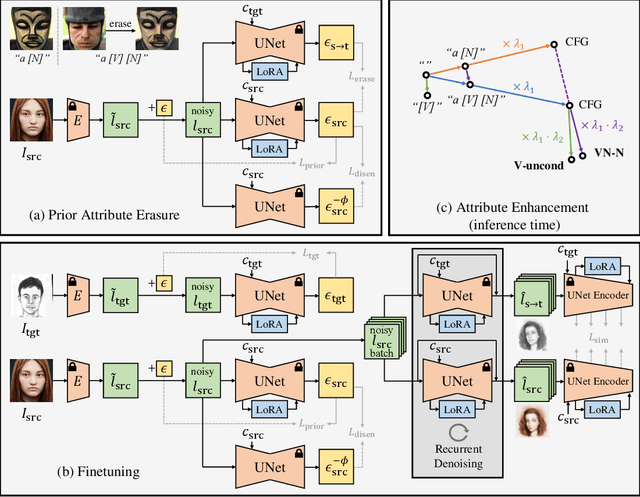
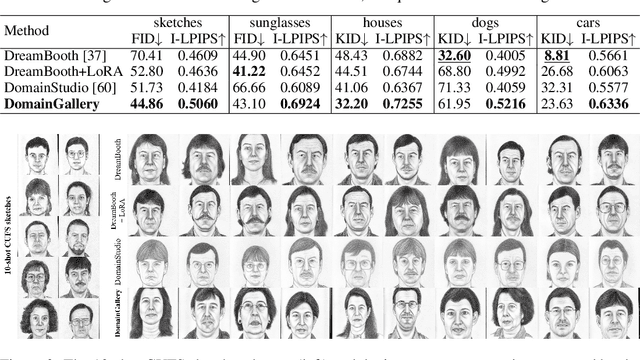
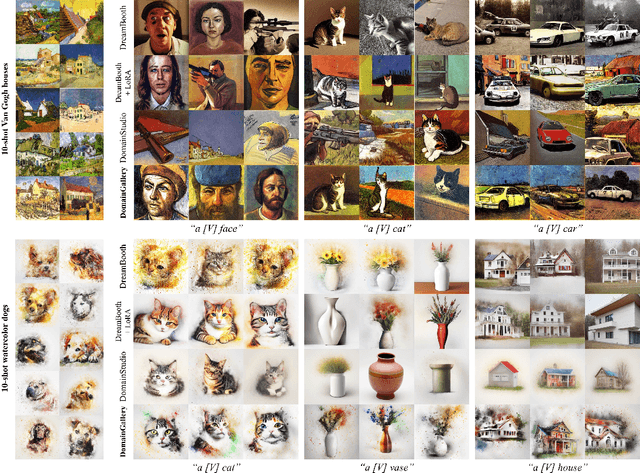
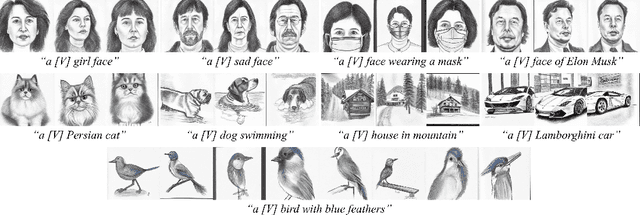
Abstract:The recent progress in text-to-image models pretrained on large-scale datasets has enabled us to generate various images as long as we provide a text prompt describing what we want. Nevertheless, the availability of these models is still limited when we expect to generate images that fall into a specific domain either hard to describe or just unseen to the models. In this work, we propose DomainGallery, a few-shot domain-driven image generation method which aims at finetuning pretrained Stable Diffusion on few-shot target datasets in an attribute-centric manner. Specifically, DomainGallery features prior attribute erasure, attribute disentanglement, regularization and enhancement. These techniques are tailored to few-shot domain-driven generation in order to solve key issues that previous works have failed to settle. Extensive experiments are given to validate the superior performance of DomainGallery on a variety of domain-driven generation scenarios. Codes are available at https://github.com/Ldhlwh/DomainGallery.
Stochastic Layer-Wise Shuffle: A Good Practice to Improve Vision Mamba Training
Aug 30, 2024



Abstract:Recent Vision Mamba models not only have much lower complexity for processing higher resolution images and longer videos but also the competitive performance with Vision Transformers (ViTs). However, they are stuck into overfitting and thus only present up to base size (about 80M). It is still unclear how vanilla Vision Mamba (Vim) can be efficiently scaled up to larger sizes, which is essentially for further exploitation. In this paper, we propose a stochastic layer-wise shuffle regularization, which empowers successfully scaling non-hierarchical Vision Mamba to a large size (about 300M) in a supervised setting. Specifically, our base and large-scale ShuffleMamba models can outperform the supervised ViTs of similar size by 0.8\% and 1.0\% classification accuracy on ImageNet1k, respectively, without auxiliary data. When evaluated on the ADE20K semantic segmentation and COCO detection tasks, our ShuffleMamba models also show significant improvements. Without bells and whistles, the stochastic layer-wise shuffle has the following highlights: (1) \textit{Plug and play:} it does not change model architectures and will be omitted in inference. (2) \textit{Simple but effective:} it can improve the overfitting in Vim training and only introduce random token permutation operations. (3) \textit{Intuitive:} the token sequences in deeper layers are more likely to be shuffled as they are expected to be more semantic and less sensitive to patch positions. Code and models will be available at https://github.com/huangzizheng01/ShuffleMamba.
 Add to Chrome
Add to Chrome Add to Firefox
Add to Firefox Add to Edge
Add to Edge